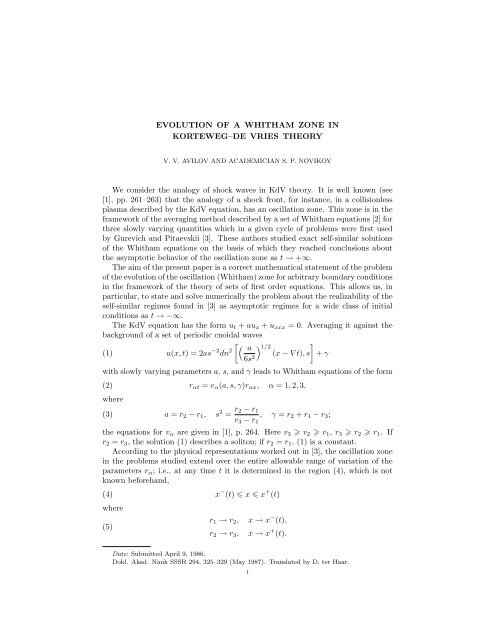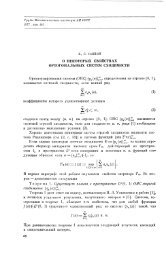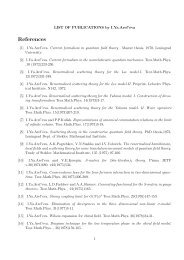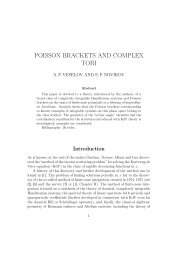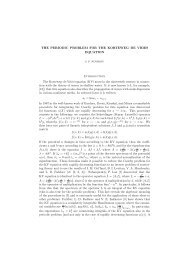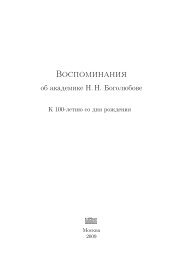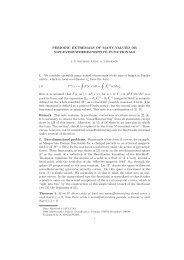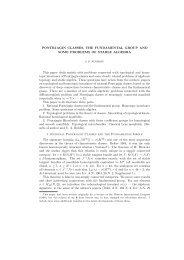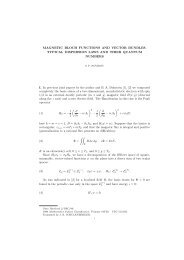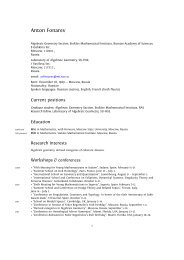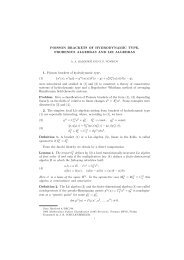Evolution of the Whitham zone in the Korteweg-de Vries theory
Evolution of the Whitham zone in the Korteweg-de Vries theory
Evolution of the Whitham zone in the Korteweg-de Vries theory
You also want an ePaper? Increase the reach of your titles
YUMPU automatically turns print PDFs into web optimized ePapers that Google loves.
EVOLUTION OF A WHITHAM ZONE INKORTEWEG–DE VRIES THEORYV. V. AVILOV AND ACADEMICIAN S. P. NOVIKOVWe consi<strong>de</strong>r <strong>the</strong> analogy <strong>of</strong> shock waves <strong>in</strong> KdV <strong>the</strong>ory. It is well known (see[1], pp. 261–263) that <strong>the</strong> analogy <strong>of</strong> a shock front, for <strong>in</strong>stance, <strong>in</strong> a collisionlessplasma <strong>de</strong>scribed by <strong>the</strong> KdV equation, has an oscillation <strong>zone</strong>. This <strong>zone</strong> is <strong>in</strong> <strong>the</strong>framework <strong>of</strong> <strong>the</strong> averag<strong>in</strong>g method <strong>de</strong>scribed by a set <strong>of</strong> <strong>Whitham</strong> equations [2] forthree slowly vary<strong>in</strong>g quantities which <strong>in</strong> a given cycle <strong>of</strong> problems were first usedby Gurevich and Pitaevskii [3]. These authors studied exact self-similar solutions<strong>of</strong> <strong>the</strong> <strong>Whitham</strong> equations on <strong>the</strong> basis <strong>of</strong> which <strong>the</strong>y reached conclusions about<strong>the</strong> asymptotic behavior <strong>of</strong> <strong>the</strong> oscillation <strong>zone</strong> as t → +∞.The aim <strong>of</strong> <strong>the</strong> present paper is a correct ma<strong>the</strong>matical statement <strong>of</strong> <strong>the</strong> problem<strong>of</strong> <strong>the</strong> evolution <strong>of</strong> <strong>the</strong> oscillation (<strong>Whitham</strong>) <strong>zone</strong> for arbitrary boundary conditions<strong>in</strong> <strong>the</strong> framework <strong>of</strong> <strong>the</strong> <strong>the</strong>ory <strong>of</strong> sets <strong>of</strong> first or<strong>de</strong>r equations. This allows us, <strong>in</strong>particular, to state and solve numerically <strong>the</strong> problem about <strong>the</strong> realizability <strong>of</strong> <strong>the</strong>self-similar regimes found <strong>in</strong> [3] as asymptotic regimes for a wi<strong>de</strong> class <strong>of</strong> <strong>in</strong>itialconditions as t → −∞.The KdV equation has <strong>the</strong> form u t + uu x + u xxx = 0. Averag<strong>in</strong>g it aga<strong>in</strong>st <strong>the</strong>background <strong>of</strong> a set <strong>of</strong> periodic cnoidal waves[ ( a) ]1/2(1) u(x, t) = 2as −2 dn 2 (x − V t), s6s 2 + γwith slowly vary<strong>in</strong>g parameters a, s, and γ leads to <strong>Whitham</strong> equations <strong>of</strong> <strong>the</strong> form(2) r αt = v α (a, s, γ)r αx , α = 1, 2, 3,where(3) a = r 2 − r 1 , s 2 = r 2 − r 1r 3 − r 1, γ = r 2 + r 1 − r 3 ;<strong>the</strong> equations for v α are given <strong>in</strong> [1], p. 264. Here v 3 v 2 v 1 , r 3 r 2 r 1 . Ifr 2 = r 3 , <strong>the</strong> solution (1) <strong>de</strong>scribes a soliton; if r 2 = r 1 , (1) is a constant.Accord<strong>in</strong>g to <strong>the</strong> physical representations worked out <strong>in</strong> [3], <strong>the</strong> oscillation <strong>zone</strong><strong>in</strong> <strong>the</strong> problems studied extend over <strong>the</strong> entire allowable range <strong>of</strong> variation <strong>of</strong> <strong>the</strong>parameters r α ; i.e., at any time t it is <strong>de</strong>term<strong>in</strong>ed <strong>in</strong> <strong>the</strong> region (4), which is notknown beforehand,(4) x − (t) x x + (t)where(5)r 1 → r 2 ,r 2 → r 3 ,x → x − (t),x → x + (t).Date: Submitted April 9, 1986.Dokl. Akad. Nauk SSSR 294, 325–329 (May 1987). Translated by D. ter Haar.1
2 V. V. AVILOV AND ACADEMICIAN S. P. NOVIKOVFigure 1. <strong>Evolution</strong> <strong>of</strong> <strong>the</strong> s<strong>in</strong>gle-valued function l(z, t) =t −1/2 r(z, t) (z = xt −3/2 ) <strong>of</strong> problem 2. The <strong>in</strong>itial condition (t = 1)<strong>in</strong> <strong>the</strong> oscillation <strong>zone</strong> corresponds to a perturbation <strong>of</strong> <strong>the</strong> selfsimilarsolution; at t = 2 this distortion is appreciably dim<strong>in</strong>ished.The self-similar solution is <strong>in</strong>dicated by dots.Outsi<strong>de</strong> <strong>the</strong> range (4) <strong>the</strong>re are no oscillations and <strong>the</strong> functions r α (x, t) are not<strong>de</strong>f<strong>in</strong>ed; at <strong>the</strong> boundary <strong>of</strong> (4) <strong>the</strong> solution <strong>of</strong> Eq. (2) must be jo<strong>in</strong>ed cont<strong>in</strong>uouslyto <strong>the</strong> solution <strong>of</strong> <strong>the</strong> Hopf equation u t + uu x = 0, obta<strong>in</strong>ed from <strong>the</strong> KdV bydropp<strong>in</strong>g <strong>the</strong> dispersion term, where u(x, t) is <strong>de</strong>term<strong>in</strong>ed outsi<strong>de</strong> <strong>the</strong> <strong>zone</strong> (4):(6)u(x − (t), t) = r 3 (x − (t), t),u(x + (t), t) = r 1 (x + (t), t).It follows from (5) and (6) that <strong>the</strong> solution on <strong>the</strong> whole x axis is <strong>de</strong>scribed by<strong>the</strong> cont<strong>in</strong>uous function r(x, t) which is three-valued <strong>in</strong> <strong>the</strong> oscillation region (4),r = (r 1 , r 2 , r 3 ), and s<strong>in</strong>gle-valued outsi<strong>de</strong> that region, r = u(x, t) (see Fig. 1).Problem. Give <strong>the</strong> ma<strong>the</strong>matically correct statement <strong>of</strong> <strong>the</strong> Cauchy problem formultiple-valued functions r(x, t) which allows us to study <strong>the</strong> temporal evolution<strong>of</strong> <strong>the</strong> oscillation <strong>zone</strong> (4).For a more complete and rigorous study <strong>the</strong> basis <strong>of</strong> such a statement must follow<strong>of</strong> course from <strong>the</strong> exact KdV <strong>the</strong>ory. We have, however, <strong>de</strong>liberately restricted <strong>the</strong>discussion to <strong>the</strong> <strong>the</strong>ory <strong>of</strong> first-or<strong>de</strong>r systems which may have a broa<strong>de</strong>r mean<strong>in</strong>gthan <strong>the</strong> KdV <strong>the</strong>ory.
EVOLUTION OF A WHITHAM ZONE IN KORTEWEG–DE VRIES THEORY 3Hydrodynamic systems without dissipation have <strong>the</strong> form(7) u α t = v α β (u)u β x,where u α (x, t) is a vector function, α = 1, 2, . . . , k. The form <strong>of</strong> (7) is conservedun<strong>de</strong>r nonl<strong>in</strong>ear substitution <strong>of</strong> u(w). If <strong>the</strong> matrix vβ α (u) is diagonal, <strong>the</strong> fieldsu α are called Riemann <strong>in</strong>variants. For <strong>in</strong>stance, for <strong>Whitham</strong>’s system (2), k = 3,<strong>the</strong> quantities u α = r α are <strong>the</strong> Riemann <strong>in</strong>variants <strong>of</strong> (2). Recently, a <strong>the</strong>ory <strong>of</strong>Hamiltonian systems <strong>of</strong> <strong>the</strong> form (7) and <strong>of</strong> <strong>the</strong> Poisson brackets connected with<strong>the</strong>m has been <strong>de</strong>veloped [4]. One <strong>of</strong> <strong>the</strong> authors <strong>of</strong> that paper hypo<strong>the</strong>sized thata system <strong>of</strong> <strong>the</strong> form (7) is <strong>in</strong>tegrate if, first, it is Hamiltonian and, secondly, ithas Riemann <strong>in</strong>variants. In some sense, this hypo<strong>the</strong>sis was proved <strong>in</strong> [5]. Theprocedure <strong>of</strong> [5] allows us to f<strong>in</strong>d some exact (“on average f<strong>in</strong>ite-<strong>zone</strong>d”) solutionswhich have as yet not been studied. The <strong>the</strong>orem follow<strong>in</strong>g from [5] about <strong>the</strong>complete <strong>in</strong>tegrability <strong>of</strong> <strong>Whitham</strong>’s system (2) is <strong>of</strong> a formal, local nature. Itsapplicability to a particular global class <strong>of</strong> functions r α (x, t) has not been studied.Even more questionable is <strong>the</strong> applicability <strong>of</strong> this statement to <strong>the</strong> physically<strong>in</strong>terest<strong>in</strong>g class <strong>de</strong>scribed above, where <strong>the</strong> <strong>Whitham</strong> equation acts only <strong>in</strong> <strong>the</strong>f<strong>in</strong>ite range (4) and is jo<strong>in</strong>ed on <strong>the</strong> boundary to <strong>the</strong> solution <strong>of</strong> <strong>the</strong> trivial Hopfequation; <strong>the</strong> range (4) changes here with time <strong>in</strong> a way not known as yet.The system (2) possesses self-similar solutions <strong>of</strong> <strong>the</strong> form (8) with arbitraryexponent γ:(8) r α (x, t) = t γ l α (xt −1−γ ) = t γ l α (z).An important role below is played by <strong>the</strong> solution for γ = 1/2 found <strong>in</strong> [3] (see [1],pp. 280–284). Let z = xt −3/2 . Outsi<strong>de</strong> <strong>the</strong> <strong>zone</strong> (4) we have u(x, t) = t 1/2 θ(z),where z = θ − θ 3 . At <strong>the</strong> edges <strong>of</strong> (4), where x = x ± (t), all l ± α can be expressed <strong>in</strong>terms <strong>of</strong> z ± from <strong>the</strong> conditions <strong>of</strong> cont<strong>in</strong>uity and constancy <strong>of</strong> <strong>the</strong> <strong>zone</strong> (4) <strong>in</strong> <strong>the</strong>self-similar variable z (see [1], p. 281).Such a solution exists and is unique, if l 3 > 0, l 1 < 0, and all l α are cont<strong>in</strong>uousalong with <strong>the</strong>ir first <strong>de</strong>rivatives <strong>in</strong> <strong>the</strong> region z − < z < z + . At <strong>the</strong> po<strong>in</strong>t z 0 , wherel 2 (z 0 ) = 0, <strong>the</strong> second <strong>de</strong>rivatives apparently are no longer cont<strong>in</strong>uous. Calculationsshow that(9) z − ≈ −1.141, z + ≈ 0.117, z 0 ≈ −1.11.We now turn to our problem. The class <strong>of</strong> multiple-valued cont<strong>in</strong>uous functionsr(x, t) must satisfy conditions (4)–(6). Moreover, <strong>the</strong>se functions must be smoothclass C 1 functions outsi<strong>de</strong> <strong>the</strong> po<strong>in</strong>ts x ± (t). They should be assumed to be smoo<strong>the</strong>routsi<strong>de</strong> <strong>zone</strong> (4). In <strong>the</strong> vic<strong>in</strong>ity <strong>of</strong> <strong>the</strong> po<strong>in</strong>ts on <strong>the</strong> curves x ± (t), <strong>the</strong> hypo<strong>the</strong>sis<strong>of</strong> s<strong>in</strong>gle-valuedness and <strong>of</strong> smoothness <strong>of</strong> <strong>the</strong> <strong>in</strong>verse function must be satisfied.This means that for any fixed t 1 <strong>the</strong> behavior <strong>of</strong> <strong>the</strong> quantity r α as x → x ± (t)is <strong>de</strong>term<strong>in</strong>ed from Eqs. (10)–(13) at <strong>the</strong> given time t:(10)(11)Here we have(12)(13)x ′′ = (a + + b + (r − r + ))f(1 − s 2 ) + O(r − r + ) 3 ,x ′′ = x − x + 0, f(y) = y 2 [log(16/|y|) + 1/2];x ′ = a − (r − r − ) 2 + b − (r − r − ) 3 + o(r − r − ) 3 , x ′ = x − x − 0.dx + /dt = v + 2 = v+ 3 , dr+ /dt = −|r + 3 − r+ 1 |2 /(12a + ),dx − /dt = v − 1 = v− 2 , dr− /dt = −1/(2a − ).
4 V. V. AVILOV AND ACADEMICIAN S. P. NOVIKOVIf <strong>the</strong>se conditions are satisfied, we call a multiple-valued function admissible at <strong>the</strong>given time t.Assertion. The <strong>Whitham</strong> equation, toge<strong>the</strong>r with <strong>the</strong> Hopf equation, <strong>de</strong>term<strong>in</strong>esuniquely <strong>the</strong> temporal evolution <strong>of</strong> <strong>the</strong> admissible multiple-valued functions r(x, t).Although <strong>the</strong>re is no ma<strong>the</strong>matically rigorous pro<strong>of</strong> <strong>of</strong> this assertion, <strong>the</strong> presentauthors have constructed a numerical realization <strong>of</strong> this evolution applicable to tw<strong>of</strong>unctional classes (boundary conditions) correspond<strong>in</strong>g to two physical problems(see [1]).Problem 1. Decay <strong>of</strong> an <strong>in</strong>itial discont<strong>in</strong>uity for <strong>the</strong> KdV. Here we haver(x, t) → 1,r(x, t) → 0,x → −∞,x → +∞.Problem 2. Dispersive analog <strong>of</strong> a shock front. Here <strong>the</strong> boundary conditions arer(x, t) − u 0 (x, y) → 0, |x| → ∞, x = u 0 t − u 3 0.In each problem we assume that <strong>the</strong> rate at which <strong>the</strong> limit is reached as |x| → ∞is sufficiently fast (exponential).Us<strong>in</strong>g (2), we carry out <strong>the</strong> numerical calculation by <strong>the</strong> characteristics methodoutsi<strong>de</strong> small regions near <strong>the</strong> po<strong>in</strong>ts x ± (t). In <strong>the</strong> vic<strong>in</strong>ity <strong>of</strong> <strong>the</strong>se po<strong>in</strong>ts <strong>the</strong>quantity r(x, t) was <strong>in</strong>terpolated by Eqs. (10)–(13), where a ± (t) and b ± (t) were<strong>de</strong>term<strong>in</strong>ed by jo<strong>in</strong><strong>in</strong>g up with <strong>the</strong> numerical solution. This enabled us to construct<strong>in</strong> each step <strong>in</strong> time <strong>the</strong> extension <strong>of</strong> <strong>the</strong> oscillation <strong>zone</strong> (4), s<strong>in</strong>ce <strong>the</strong> <strong>de</strong>rivativesẋ ± (t) and ṙ ± (t) are known. Along <strong>the</strong> l<strong>in</strong>e x − (t) <strong>the</strong> characteristics for r 1 and r 2are tangent and along x + (t) <strong>the</strong> characteristics for r 2 and r 3 are tangent. Theseare <strong>the</strong> s<strong>in</strong>gular l<strong>in</strong>es: <strong>the</strong> characteristic r 1 reaches <strong>the</strong> l<strong>in</strong>e x − (t), touches it, and<strong>the</strong>n leaves it as <strong>the</strong> characteristic r 2 . In exactly <strong>the</strong> same way, <strong>the</strong> characteristicr 3 arrives along x + (t), touches <strong>the</strong> l<strong>in</strong>e x + (t), and <strong>the</strong>n leaves as r 2 <strong>in</strong> <strong>the</strong> region<strong>of</strong> <strong>the</strong> (x, t)-plane <strong>in</strong>si<strong>de</strong> <strong>the</strong> curves [x + (t), x − (t)]. At each step <strong>in</strong> time around <strong>the</strong>boundaries <strong>the</strong>re is a transition <strong>of</strong> one characteristic <strong>in</strong>to ano<strong>the</strong>r. In <strong>the</strong> numericalcalculation <strong>the</strong> characteristics <strong>the</strong>mselves are not calculated <strong>in</strong> small regions around<strong>the</strong> curves x ± (t).As boundary conditions at t = 1 for problem 2 we <strong>in</strong>troduced various admissibleperturbations <strong>of</strong> <strong>the</strong> self-similar Gurevich–Pitaevskii regime (see above).The conclusions are <strong>the</strong> follow<strong>in</strong>g: any admissible <strong>in</strong>itial condition r(x, t), whichis sufficiently C 1 -close to <strong>the</strong> self-similar solution <strong>of</strong> problem 2 (see above), evolvesan <strong>in</strong>f<strong>in</strong>ite time without <strong>the</strong> appearance <strong>of</strong> any s<strong>in</strong>gularities (see Fig. 1) and ast → ∞ <strong>the</strong> functions l α (z, t) tend to <strong>the</strong> self-similar solution (8), where r α (x, t) =t 1/2 l α (z, t). There exists a f<strong>in</strong>ite threshold – <strong>the</strong> <strong>de</strong>gree <strong>of</strong> remoteness <strong>of</strong> <strong>the</strong> <strong>in</strong>itialperturbation from <strong>the</strong> self-similar solution – after which <strong>the</strong> evolution may be(and sometimes is) such that <strong>the</strong>re appears <strong>the</strong> usual hydrodynamic steepen<strong>in</strong>g andafterwards <strong>the</strong> <strong>in</strong>version <strong>of</strong> <strong>the</strong> front for r α . We do not know <strong>the</strong> numerical characteristics<strong>of</strong> this threshold. In or<strong>de</strong>r that <strong>the</strong> evolution <strong>of</strong> r(x, t) be exten<strong>de</strong>d over an<strong>in</strong>f<strong>in</strong>ite time as t → +∞, it is necessary (although not sufficient) that each s<strong>in</strong>glevaluedcont<strong>in</strong>uous branch <strong>of</strong> <strong>the</strong> function r(x, t) be a monotonic function <strong>of</strong> x attime t. This statement is correct <strong>in</strong> all problems consi<strong>de</strong>red by us, as <strong>the</strong> numericalexperiment shows. Un<strong>de</strong>r <strong>the</strong> same necessary condition <strong>in</strong> problem 1, a wi<strong>de</strong> class<strong>of</strong> admissible (although not all) <strong>in</strong>itial conditions <strong>in</strong> <strong>the</strong> evolution process tend to
EVOLUTION OF A WHITHAM ZONE IN KORTEWEG–DE VRIES THEORY 5Figure 2. <strong>Evolution</strong> <strong>of</strong> <strong>the</strong> s<strong>in</strong>gle-valued function r(z, t) (z =xt −1 ) <strong>of</strong> problem 1. The <strong>in</strong>itial condition (t = 1) <strong>in</strong>si<strong>de</strong> <strong>the</strong> oscillation<strong>zone</strong> corresponds to <strong>the</strong> self-similar solution <strong>of</strong> problem 2and outsi<strong>de</strong> this <strong>zone</strong> tends to a constant.a regime which is self-similar with exponent γ = 0, where z = xt −1 , r 1 → const,r 3 → const, and v 2 → z. This limit<strong>in</strong>g regime is <strong>de</strong>scribed <strong>in</strong> [1], pp. 268–270. Byitself it is not conta<strong>in</strong>ed among <strong>the</strong> admissible functions, but is found to be a limit(see Fig. 2).From a methodological po<strong>in</strong>t <strong>of</strong> view, it is useful also to consi<strong>de</strong>r <strong>the</strong> case (problem3) when x + = +∞, x − = −∞, and r α (x, t) → r α ± as x → ±∞, wherer1 − = r− 2 < r− 3 , r+ 2 = r+ 3 > r+ 1 (<strong>in</strong>f<strong>in</strong>ite oscillation <strong>zone</strong>).Numerical calculations show that <strong>in</strong> or<strong>de</strong>r that <strong>the</strong> evolution does not for allt → +∞ lead to <strong>the</strong> usual hydrodynamic <strong>in</strong>version <strong>of</strong> <strong>the</strong> front (i.e., <strong>in</strong> or<strong>de</strong>r that|r αx | be f<strong>in</strong>ite for all α), it is necessary and sufficient that at <strong>the</strong> <strong>in</strong>itial time t = 1<strong>the</strong> condition for a monotonic <strong>in</strong>crease <strong>of</strong> r α (x, t) is satisfied:(14) r αx 0, −∞ < x < +∞.If r 1 + < r− 3 <strong>the</strong>re is a f<strong>in</strong>ite range <strong>of</strong> <strong>the</strong> self-similar z = xt−1 , where <strong>the</strong> solutiontends, as t → ∞, to <strong>the</strong> self-similar solution <strong>of</strong> problem 1: r 3 = r3 − , r 1 = r 1 + , v 2 = z(see Fig. 3). Hence it follows that <strong>the</strong> condition that <strong>the</strong>re be no s<strong>in</strong>gularities <strong>in</strong><strong>the</strong> evolution process can <strong>in</strong> pr<strong>in</strong>ciple be formulated only <strong>in</strong> terms <strong>of</strong> <strong>the</strong> Riemann<strong>in</strong>variants r α . It cannot be expressed <strong>in</strong> terms <strong>of</strong> <strong>the</strong> physical characteristics <strong>of</strong><strong>the</strong> <strong>in</strong>itial condition – such as <strong>the</strong> average velocity ū, <strong>the</strong> quantities u m<strong>in</strong> and u max(see [1], p. 264), <strong>the</strong> average momentum <strong>de</strong>nsity ¯p = u 2 , and <strong>the</strong> average energy ¯ε,
6 V. V. AVILOV AND ACADEMICIAN S. P. NOVIKOVFigure 3. <strong>Evolution</strong> <strong>of</strong> <strong>the</strong> <strong>in</strong>f<strong>in</strong>ite oscillation <strong>zone</strong> <strong>of</strong> problem 3.The functions r α (z, t) (z = xt −1 ), α = 1, 2, 3, at <strong>the</strong> <strong>in</strong>itial timet = 1 are shown by dots, <strong>the</strong> full drawn l<strong>in</strong>es correspond to t = 11.whose graphs may appear to be physically mean<strong>in</strong>gful both when (14) is satisfiedand when it is violated.References[1] S. P. Novikov (ed.), Theory <strong>of</strong> Solitons, Consultants Bureau, New York.[2] G. B. <strong>Whitham</strong>, Proc. R. Soc. A283, 238 (1965).[3] A. V. Gurevich and L. P. Pitaevskii, Zh. Eksp. Teor. Fiz. 65, 590 (1973) [Sov. Phys. JETP38, 291 (1974)].[4] B. A. Dubrov<strong>in</strong> and S. P. Novikov. Dokl. Akad. Nauk SSSR 270, 781 (1984).[5] S. P. Tsarev, Dokl. Akad. Nauk SSSR 282, 280 (1985).L.D. Landau Institute <strong>of</strong> Theoretical Physics, Aca<strong>de</strong>my <strong>of</strong> Sciences <strong>of</strong> <strong>the</strong> USSR,Moscow


